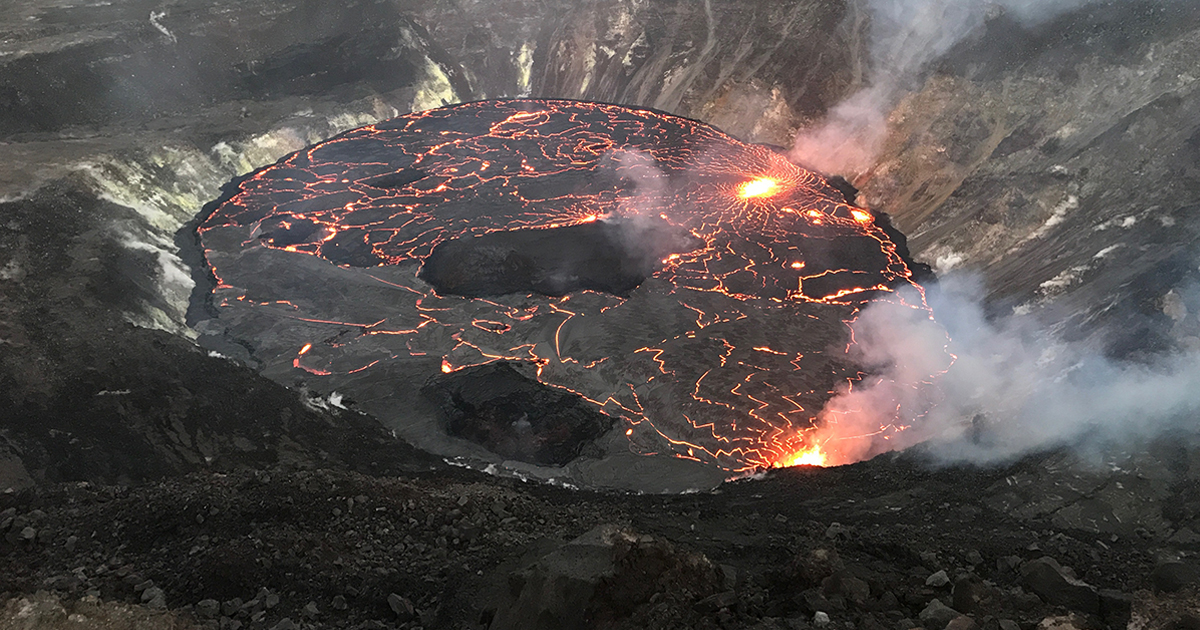You may have already heard that Hawaii’s famous volcano, Kilauea, is erupting again. The new eruption started on September 29 and is still ongoing as of the time of writing this post.
Like the prior eruption in December 2020, this recent activity is confined within the volcano’s Halema’uma’u crater, so there is no danger to the Big Island’s communities. The new lava continues to fill the crater that collapsed in 2018 and creates a fresh lava lake on top of the older one. This pattern of summit collapse and subsequent lava lake filling is one that Kilauea has exhibited in the past. Multiple active vents continue to feed the growing lava lake that rose approximately 65 ft since the eruption started.

While it’s impossible to predict precisely how long the current eruption may last, scientists expect that more summit and upper rift zone eruptions are likely in the coming years as Kilauea continues to re-pressurize and re-establish magma pathways after the 2018 eruption.
You can see incredible photos and images of the current eruption here.

Living near the live volcano is undoubtedly exciting, but did you know that the Big Island is home to not one but four active volcanoes and is the liveliest of all islands? Between 1912 and 2012, there were nearly 50 Kīlauea eruptions, 12 Mauna Loa eruptions, and one Hualālai intrusion of magma. Mauna Kea most recently erupted only about 4,000 years ago and is considered an active volcano.
Here are some interesting facts about Hawaii’s active volcanos.

Kilauea, the youngest and most active volcano on the Big Island, erupted almost continuously from 1983 to 2018. From 2008 to 2018, there was a lava lake within the Halema’uma’u crater at the volcano’s summit. In 2018, Kīlauea experienced the largest lower East Rift Zone eruption and summit collapse in at least 200 years. An eruption from December 2020 to May 2021 fed a lava lake in the Halema’uma’u crater at the summit. Since September 29, 2021, an eruption has been ongoing within the Halema’uma’u crater. About 90 percent of the volcano is covered with lava flows less than 1,100 years in age.

Mauna Loa, the largest volcano on Earth, has erupted 33 times since 1843. The most recent eruption in 1984 lasted 22 days and produced lava flows which reached to within about 4.5 miles of Hilo, the largest population center on the Island of Hawai’i. Lava flows less than 4,000 years old cover about 90 percent of the volcano.

Hualālai, the third most active volcano on the Island of Hawai’i, has erupted three times in the past 1,000 years and eight times in the past 1,500 years. The most recent eruption in 1801 generated a lava flow that reached the ocean and now underlies the Kona International Airport. Lava flows less than 5,000 years old cover about 80 percent of the volcano.

Mauna Kea, the highest volcano on the Island of Hawai’i, erupted most recently between about 6,000 and 4,500 years ago from at least seven separate summit-area vents, producing lava flows and cinder cones. Glaciers covered parts of the volcano’s summit area during the recent ice ages, the only Hawaiian volcano known to have been glaciated.
A part of Mauna Kea’s glacial past is Lake Waiau, located just below the summit. It also is one of the highest lakes in the United States with an elevation of 13020 ft and is the only alpine lake in the state of Hawaiʻi.
You can hike to the lake, though we would not recommend it for beginners. Learn more about the lake here.

Lō‘ihi, the youngest and only known active Hawaiian submarine volcano, erupted most recently in 1996 during an earthquake swarm of more than 4,000 events. The volcano’s summit is about 3,179 ft below sea level, located 22 miles southeast of the Island of Hawai’i.
The newest Hawaiian island, Lōʻihi, will likely emerge from the ocean in the next 100,000 years, and possibly in less than half that time. After that, the volcano may potentially merge with the Big Island and may one day become a snow-capped mountain like the nearby summits of Mauna Kea and Mauna Loa volcanoes.

The current eruption event at Kilauea presents a great opportunity for visitors to see a live volcano in action. So if you are planning to come to the island this fall, be sure to visit Hawaii Volcanoes National Park. Explore towering tree fern forests, feel the heat of volcanic action under your feet at Steam Vents, then make your way over to the main highlight, Kīlauea Caldera, where you can witness the volcano’s fiery lava lake. Afterward, head over to the historic Volcano House Hotel, where you can have a cocktail by the fireplace or enjoy excellent cuisine against the spectacular backdrop of Kīlauea’s powerful glow. Just a tip: the best viewing of Kīlauea Caldera is at night.
Save on your Hawaii vacation rental
Remember, you can always save 10% on your vacation rental when you book direct with us and mention “Aloha escape” in your reservation.
We hope to see you soon – a hui hou!
Images courtesy of USGS, Inoptia.
